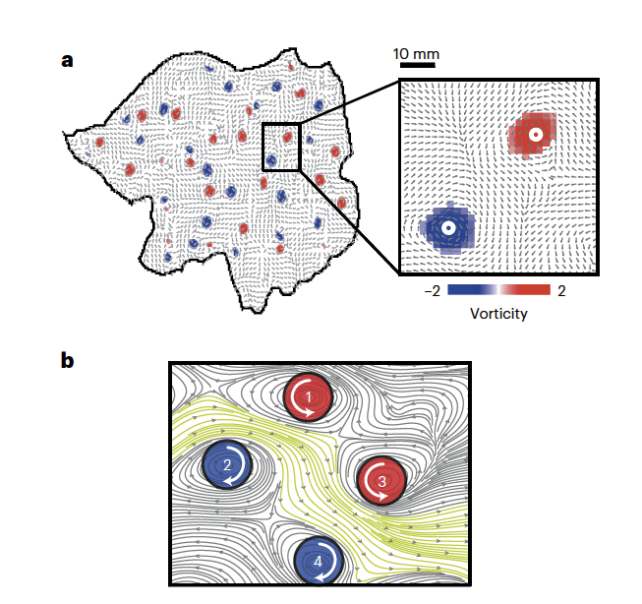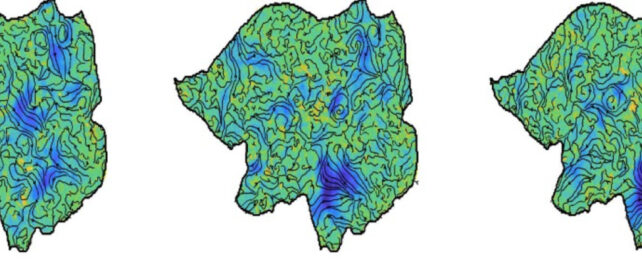There are many layers to the human brain. From its wrinkled exterior to its darkest depths, scientists are trying to understand them all. But in honing in on the brain's intricate neural circuitry, they appear to have overlooked patterns of activity swirling on the surface.
A team of fluid physicists from the Universty of Sydney in Australia and Fudan University in China discovered brain signals rippling across the brain's outermost layer of neural tissue, the cerebral cortex, on scans of 100 young adults' brains. Signals naturally arranged as spirals, like vortices in a draining bathtub or whirlwinds of turbulent air.
"Gaining insights into how the spirals are related to cognitive processing could significantly enhance our understanding of the dynamics and functions of the brain," says senior author Pulin Gong, a physicist at the University of Sydney.
The cortex is the wrinkled outer layer of neuron-dense tissue that folds into the two hemispheres of our brain, responsible for computing complex cognitive functions such as language and storing memories.
Neuroscientists have mostly focused on mapping brain activity from the bottom up to understand the inner workings of regions like the cortex: imaging cells to determine how they communicate as networks that give rise to their function.
In an exciting twist, the team analyzed brain imaging data collected as part of the Human Connectome Project using methods most familiar to fluid physicists studying complex wave patterns in turbulent flows.
Functional MRI scans produce imaging data that shows when and where the brain 'lights up' in a burst of activity, flooded with oxygenated blood. The spiraling patterns identified in the data resemble kaleidoscopic waves or, when simplified into directional vortices, circular pressure lines on a weather map.

"These spiral patterns exhibit intricate and complex dynamics, moving across the brain's surface while rotating around central points known as phase singularities," explains Gong.
"Much like vortices act in turbulence, the spirals engage in intricate interactions, playing a crucial role in organizing the brain's complex activities," he hypothesizes.
Rhythmic, spiraling waves have been detected before in neural circuits, moving through local brain regions that handle sensory inputs such as the visual, auditory and somatosensory cortices.
These traveling waves are intriguing enough on a cellular level, especially when you consider how turbulent vortices have also been observed elsewhere in the body and nature: in suspensions of swimming bacteria, biochemical signaling of the heart and in the membranes of living cells.

But how whirlpool-like waves may materialize across the cerebral cortex as a whole hadn't been explored until now, leaving a gap in understanding how brain functions in each of the regions could be connected.
The spiral waves appeared to span multiple networks of interconnected cells and were situated at precise anatomical locations, suggesting they may play some role in coordinating brain activity.
This working theory was tested with additional analyses, revealing the brain spirals switched directions to rejig brain activity during language processing and working memory tasks such as listening to stories and answering math problems.
"One key characteristic of these brain spirals is that they often emerge at the boundaries that separate different functional networks in the brain," explains University of Sydney graduate physics student Yiben Xu.
At those locations, the researchers think the rotating spirals may act as a gate, letting brain activity flow through to another region when the spins are opposing, or as a wall, blocking it off when they spin the same direction.
"Through their rotational motion, they effectively coordinate the flow of activity between these networks," Xu suggests.
The findings fit an alternative theory of how complex brain functions arise from the activity of individual cells, firing away. The theory suggests wave-like patterns of brain activity are sculpted by the shape of the brain itself – the folds, grooves and contours – rather than its interconnections.
Neurobiologist Kentaroh Takagaki of Tokushima University in Japan, who was not involved in the work, says Gong and colleagues' results also "present a stark counterpoint" to the columnar hypothesis of the brain, which describes how the cortex is organized into columns of neurons that process information in blocks.
However, the fMRI recordings used in the study only captured slow-moving waves of brain activity, so more research is needed to see if similar patterns emerge in faster brain wave oscillations, and on higher resolution scans.
"By unraveling the mysteries of brain activity and uncovering the mechanisms governing its coordination, we are moving closer to unlocking the full potential of understanding cognition and brain function," Gong says.
The study has been published in Nature Human Behaviour.
